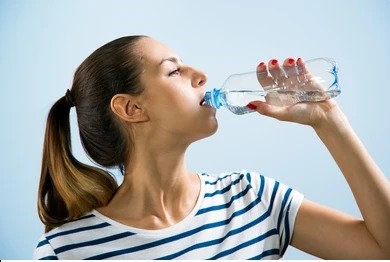Bottled Water vs Tap Water? Shocking Facts About the Dangers Inherent in Both
Edited by: TJVNews.com
Health-conscious conservationists often contemplate the question: Is water best consumed from the tap or in a plastic bottle?
As it pertains to the environment, it has been reported that not only are millions of tons of plastic bottles clogging our landfills, but it takes 1.63 liters of water to make every liter of Dasani—and the company is doing it in drought-plagued California, according to the Natural Resources Defense Council (NRDC) web site.
The NRDC web site also reported that public concerns about tap-water quality have caused bottled water sales to soar over the past couple of decades. Ads and labels drive home the perception of purity, with images of pristine glaciers and crystal-clear mountain springs. We now have “luxury” water bars and “premium” bottled water. Some people are spending 10,000 times more per gallon for bottled water than they typically are for tap.
In the United States, the U.S. Environmental Protection Agency oversees the quality of water that comes out of your tap, while the U.S. Food and Drug Administration is responsible for ensuring the safety and truthful labeling of bottled water sold nationally, as was reported on the NRDC web site. States are responsible for regulating water that is both packaged and sold within its borders (which is most of the bottled-water market), but one in five states doesn’t even bother.
It’s important to note that the federal government does not require bottled water to be safer than tap. In fact, just the opposite is true in many cases. The NRDC web site reported that tap water in most big cities must be disinfected, filtered to remove pathogens, and tested for cryptosporidium and giardia viruses. Bottled water does not have to be.
Both kinds of water are tested regularly for bacteria and most synthetic organic chemicals, but city tap is typically assessed much more frequently. For example, bottled-water plants must test for coliform bacteria just once a week; city tap needs to be tested 100 or more times a month, as was reported by the NRDC web site.
Limits on chemical pollution for both categories are almost identical, the report stated. The one place where bottled water might have the edge is in the case of lead; because many older homes have lead pipes, the EPA standard for tap water is less strict—one-third of the FDA’s standard for lead in bottled water.
In 1999, after a four-year review of the bottled-water industry and its safety standards, NRDC concluded that there is no assurance that bottled water is cleaner or safer than tap. In a shocking revelation, the NRDC web site reported that an estimated 25 percent or more of bottled water is really just tap water in a bottle—sometimes further treated, sometimes not.
Of the 1,000 bottles tested, the majority proved to be relatively clean and pure. The NRDC reported that about 22 percent of the brands tested contained chemicals at levels above state health limits in at least one sample. If consumed over a long period of time, some of those contaminants could cause cancer or other health problems for people with weakened immune systems.
The Centers for Disease Control (CDC.gov) web site reported that although illness outbreaks associated with bottled water are rarely reported, they do occur. It is important for bottled water manufacturers, distributors, and consumers to do these things:
- Protect and properly treat water before bottling
- Maintain good manufacturing processes
- Protect bottled water during shipping and storage
- Prevent contamination after consumers purchase bottled water
If you suspect an illness resulting from drinking bottled water, contact your local public health department.
Contaminated bottled water can harm your health, including causing gastrointestinal illness, reproductive problems, and neurological disorders. Infants, young children, pregnant women, the elderly, and people with weakened immune systems may be more likely to get sick from some contaminants.
The Food and Drug Administration (FDA) regulates the safety of bottled water and bases its standards on the EPA standards for tap water. If these standards are met, water is considered safe for most healthy individuals. The bottled water industry must also follow FDA’s good manufacturing practices for processing and bottling drinking water.
The NRDC reported that although tap water is for the most part considered safe to ingest, it might at times also present issues – especially if you live in a rural community with a higher likelihood of pesticide runoff contamination, or if you get your water from a private (unregulated) well or live in an older home.
The CDC web site reported that the water that comes to your tap actually contains small quantities of many other substances. Some of these are beneficial, such as the appropriate amount of a disinfectant, like chlorine, that helps keep your water safe from germs and fluoride, which helps prevent tooth decay. Other substances that might be in water can be harmful, such as lead and the germ Cryptosporidium. Filters can remove both good and bad substances from your water. Depending on your circumstances, filtering your water might not be a good idea.
There are many different types of filters available, and it can be confusing to decide whether you need one or which kind is best for you, according to the CDC web site. In many areas of the world, the water is not safe to drink, so filtration is one option to protect your health. Here are some steps to consider when determining whether you want to use a water filter, and if so, what type and functions best fit your specific needs and preferences.
Under “right-to-know” provisions in the drinking water law, all tap suppliers must provide annual quality reports to their customers, according to NRDC web site. You also can test your water yourself. Standard consumer test packages are available through large commercial labs at a relatively reasonable price. Call your state drinking-water program or the EPA Safe Drinking Water Hotline (800-426-4791) for a list of contacts.
Your water report will point out possible risks to health; fortunately, a home filter designed explicitly to strip contaminants will resolve most cases. The NRDC reports if you want to take extra precautions, you should purchase filters certified by NSF International. These models are designed to filter out specific contaminants, so you can select one based on your needs.
The CDC also reported that people with weakened immune systems, such as people with HIV, diabetes, organ transplants or going through chemotherapy, should take special precautions with the water they drink. The parasite Cryptosporidium can cause chronic or severe illness and even life-threatening symptoms in people with weakened immune systems. Healthy people would be more likely to develop a mild illness from this parasite.
Look for the following types of treatments for bottled water that protect against Cryptosporidium:
- Reverse osmosis
- Distillation
- Filtration with an absolute 1micron filter
One of the primary reasons consumers continue to purchase bottled water regardless of the potential environmental impact is due to a perception that bottled water is higher quality, more pristine water; and there is a reason for this misconception. Most advertisements for bottled water depict a fresh stream or mountain spring in order to make it seem like their bottled water is purer than tap water or other brands of bottled water. However, water that is bottled from special springs is rare, and the fact is that most bottled water comes from similar sources as your municipal water supply, meaning that there is likely nothing special about your bottled water other than its branding. In fact, Aquafina now states on its labels that its water comes from public sources. Additionally, as we will discuss below, in some cases your bottled water may be less pure than what comes out of your tap at home.
While bottled water is often depicted as being higher quality than tap water, the fact is that in many instances bottled water is glorified tap water. While some manufacturers put their water through additional filtering before bottling it, many do not and simply charge for the packaging. Thusly, even though it is likely the same water as what comes out of the tap at home, you may be paying thousands of times more for the same product when you buy bottled water. In fact, some studies have even suggested that bottled water is less safe than tap water in some places.
This is due to the fact that the municipal water supply that comes to our homes is highly regulated. The EPA regulates public tap water supplies and sets legal limits for hundreds of contaminants that could show up in water, and they regularly test for these contaminants. Alternatively, bottled water undergoes very little regulation, and recent studies have found traces of phthalates, mold, microbes, arsenic, and thousands of other contaminants in bottled water. Considering bottled water may not be as pure, or as safe, as many people think, you would likely get the purest drinking water by filtering your tap water at home.
Over 15 million U.S. households obtain their drinking water from private wells, which are not covered by the United States Environmental Protection Agency (EPA) regulations that protect public drinking water systems. The CDC also reported that although the United States has one of the safest drinking water supplies in the world, sources of drinking water can still become contaminated through naturally occurring chemicals and minerals (for example, arsenic, radon), local land use practices (for example, pesticides, chemicals, animal feeding operations), malfunctioning wastewater treatment systems (for example, sewer overflows), and other sources. Contamination of a private well can impact not only the household served by the well, but also nearby households using the same aquifer.
Owners of private wells are responsible for ensuring that their water is safe from contaminants. The CDC also reported Private wells should be checked every year for mechanical problems, cleanliness, and the presence of coliform bacteria, nitrates, and any other contaminants of local concern. A local health department or water well systems professional can help ensure delivery of high-quality water from an existing well or, if needed, help locate and construct a new well in a safer area.





